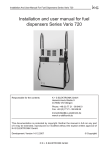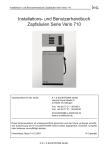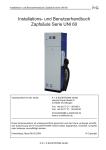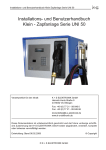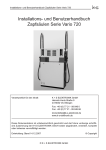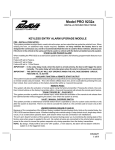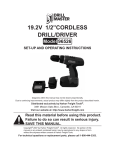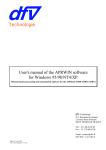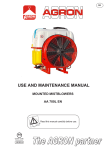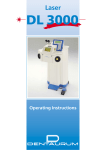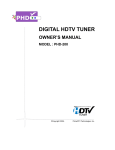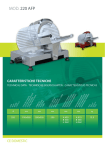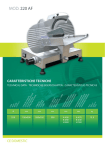Download Installation and user manual for fuel dispensers Series UNI 60
Transcript
Installation And User Manual For Fuel Dispensers Series UNI 60 Installation and user manual for fuel dispensers Series UNI 60 Responsable for the contents: K + S ELEKTRONIK GmbH Heinrich-Hertz-Straße 9 D-78052 VS-Villingen Phone: +49 (0) 77 21 - 99 846 0 Fax: +49 (0) 77 21 - 99 846 66 [email protected] www.k-s-elektronik.de This documentation is protected by copyright. Neither the manual in full nor any part of it may be extended, reproduced nor modified without the explicit written approval of K+S ELEKTRONIK GmbH. Development: Version 14.12.2007 © K + S ELEKTRONIK GmbH © Copyright Installation And User Manual For Fuel Dispensers Series UNI 60 1. Contents 2. Introduction 2.1 For the user 2.2 Safety instructions 2.3 Safety symbols 2.4 Additional important symbols at the fuelling station site 2.5 Basic safety instructions 2.6 Obligations of the operator 2.7 Compliance with instructions and regulations 2.8 Warranty 4 4 5 6 7 7 8 8 10 3. General product information 3.1 Overview 3.2 Technical data 3.3 Functional description 3.4 Description of components 3.5 Designation of components 3.6 Rating plates fuel dispenser 3.7 Explanations regarding the fuel dispenser rating plate 11 11 12 13 14 15 16 17 4. Transport, storage and unpacking 4.1 Transport 4.2 Storage 4.3 Unpacking 18 18 19 19 5. Installation 5.1 Safety instructions 5.2 Installation of the fuel dispenser 5.3 Foundation 5.3.1 Foundation plan single pump 5.3.2 Foundation frame single pump 5.4 Mechanical fuel dispenser mounting 5.4.1 Electric cables 5.4.2 Connection of the hydraulic unit 5.4.3 Electr. installation wiring 5.4.4 Underground tank 5.4.5 Above-ground tank 5.5 Fuel cable wiring 20 20 21 21 22 23 24 25 26 27 28 29 30 © K + S ELEKTRONIK GmbH Page 1 Installation And User Manual For Fuel Dispensers Series UNI 60 6. Electr. power supply 6.1 Overvoltage protection 6.2 Uninterruptible power supply 6.3 Wiring of the fuel dispenser 6.4 Supply of the pumps 6.5 Data lines 6.6 Service lines 6.7 Trouble-free cable installation 31 31 31 32 33 33 34 34 7. Fuel 7.1 7.2 7.3 7.4 7.4.1 7.4.2 7.4.3 7.5 35 35 35 36 37 37 38 38 38 dispenser operation Instructions for safe fuel dispenser operation Putting the fuel dispenser into operation Checking/changing the direction of rotation of the motor Operation of the fuel dispenser Fuel dispensing Position of the nozzle Operating mode of the fuel dispenser Switching the fuel dispenser off 8. Maintenance and service 8.1 Instructions for maintenance 8.2 Maintenance of the housing 39 40 40 9. Technical specifications 9.1 Hydraulic components 9.1.1 Flow meter KME 9.1.2 Vane pumps PA 1, PA 2 - illustration 9.1.3 Flow meter KME 9.2 Flow meter KME 41 42 42 43 43 45 10. Fuel dispenser dimensions 10.1 Single pump 46 46 11. Hazardous areas 11.1 Wiring diagram 47 48 Page 2 © K + S ELEKTRONIK GmbH Installation And User Manual For Fuel Dispensers Series UNI 60 12. Troubleshooting 12.1 Safety instructions 12.2 Malfunctions 12.2.1 Pump does not dispense fuel 12.2.2 Reduced or no fuel dispensing 12.3 After troubleshooting 49 50 50 51 52 13. Test certificates and other certificates 13.1 EC declaration of conformity 13.2 QMS certificate 53 53 54 © K + S ELEKTRONIK GmbH Page 3 Installation And User Manual For Fuel Dispensers Series UNI 60 2. Introduction 2.1 For the user About this manual This installation and user manual serves for providing the user with the necessary information and instructions facilitating complete and effective installation, parameter setting, operation and maintenance of the fuel dispenser series Uni 60. Therefore, read the corresponding chapters prior to proceeding with the installation or operation of the fuel dispenser. Observe all danger warnings and general instructions set out in this manual. This manual has been carefully worked out by the manufacturer and is an integral part of any fuel dispenser delivery according to the CE directive. The manual is arranged in individual topic-related chapters and sections and has a logical structure (learn - prepare - use - maintain). The manual and any attached documents must be kept in a safe place within reach during the whole service life of the fuel dispenser. Thus, it also constitutes an information source for operation settings and error elimination with regard to the fuel dispenser. This manual reflects the technical state-of-the-art at the date of fuel dispenser sale or delivery. This manual is subject to modifications and updates resulting from further developments. Intended use The fuel dispensers of the series UNI 60 are designed to meet only the requirements of an end user and for a maximum fueling capacity of 10,000 liters per month. These fuel dispensers are only intended for the dispensing of the following liquids other than water: Diesel, biodiesel and fuel oil Page 4 © K + S ELEKTRONIK GmbH Installation And User Manual For Fuel Dispensers Series UNI 60 2.2 Safety instructions General The user is liable for the observance of the contents of this manual. Any use contrary to the designated use described in this manual is not permitted. The user is solely responsible for any damage resulting from such use. The safety instructions are not only intended for assuring the own safety but also for the protection of persons not involved against damage to property and body. Safe operation of the fuel dispenser is hereby garanteed. The “safety instructions" must be attached in the required size according to the regulations for hazardous substances “GefStoffV”. The symbol shown (left-hand side) is used in this installation and user manual in order to draw special attention to important information and remarks. © K + S ELEKTRONIK GmbH Page 5 Installation And User Manual For Fuel Dispensers Series UNI 60 2.3 Safety symbols The following symbols draw the attention to important special notes. Attention! This pictogram draws attention to legal regulations which must be complied with regarding assembly, commissioning and use of fuel dispensers. Warning! Non-observance of these requirements can lead to injury of persons and/or damage to the fuel dispenser. Caution - electric voltage! Warning against touching electric lines and contacts. Non-observance of these requirements can cause electric shock and lead to injury of persons and damage to property. Explosion hazard! Special care is required in the case of spilled fuel. Inflammable vapours may easily lead to explosion or deflagration. Therefore, such fuel must be removed immediately by means of suitable absorbent means. Electrostatically endangered components, ESD! This means that any contact with the contact surfaces or electr. components may lead to the destruction of the electronic control unit and put the fuel dispenser out of service. Page 6 © K + S ELEKTRONIK GmbH Installation And User Manual For Fuel Dispensers Series UNI 60 2.4 Additional important symbols at the fuelling station site Explosion hazard No smoking No mobile phones No open fire The “No mobile phones” sign is especially important if one uses the mobile phone while refuelling motor gasoline at the same time. Deflagration may occur when activating the buttons. 2.5 Basic safety instructions Protection and safety devices Any protection and safety devices must be checked regularly, but at the latest when carrying our maintenance work. They may never be bypassed or ignored. Any removed safety and proection devices must be: mounted again before putting into operation checked for correct functioning. Make sure that the safety devices at the installation site (e.g. Emergency Stop button, fire fighting devices) are visible and easily accessible. © K + S ELEKTRONIK GmbH Page 7 Installation And User Manual For Fuel Dispensers Series UNI 60 2.6 Obligations of the operator Attention! The fuel dispenser is a complex unit and must fulfill high requirements. Therefore, the operator is obliged to carry out the following protection measures and to observe the safety instructions. Soiling It is required to clean the tanks and pipes and to check whether the fuel is pure (soiled filters in the fuel dispenser do not justify any repair under warranty!) before putting the fuel dispenser into operation. Power supply Before putting the fuel dispenser into operation, the electric power supply and the correct wiring must be checked in order to prevent electric shocks and to ensure explosion protection (fuels are combustibles of class I). Leakage Even in case of minor leakage in the fuel dispenser, measures must be taken to minimize the generation of vapours and to prevent escaping fuel from entering into the soil. Leakage in the interior of the fuel dispenser must be checked via the exit hole located in the middle of the front base. Lighting Ensure sufficient illumination of the refuelling area. Out of operation When not operated, the fuel dispenser must be protected against unauthorized use. 2.7 Compliance with instructions and regulations Overview UVV - Accident prevention regulation VdTÜV bulletin 651 “Electric equipment of fuelling stations” TRbF - Technical rules for inflammable liquids GefStoffV - Regulations for hazardous substances VbF - Regulations for inflammable liquids VAwS - Regulations for installations used for storage, filling and handling of substances hazardous to water VLwF - Regulations for the storage of liquids hazardous to water VDE regulations 21. BimSchV - Regulations regarding the Federal Immission Control Law Page 8 © K + S ELEKTRONIK GmbH Installation And User Manual For Fuel Dispensers Series UNI 60 ESD Directives Electro Static Discharge. Under daily conditions, persons and tools may be electrostatically charged by friction. When touching electronic components, this charge may lead to discharge and thus to destruction of the components or circuit boards. Therefore, this energy must be reduced by touching the protective earth (metallic housing parts) before proceeding with any work in the interior of the pump head. The fuel dispensers are designed for use in business and industrial areas and fulfill the requirements of the EMC directive 89/336/EEC Low-voltage directive 73/23/EEC Machinery directive 98/37/EC En DIN 13617-1:2004 Installation instructions To ensure compliance with the above mentioned directives during fuel dispenser installation, you must: observe the installation instructions described in this manual and make sure that the metallic housing parts of the fuel dispenser and the earthing conductor are connected to the same potential and no compensation current may flow. © K + S ELEKTRONIK GmbH Page 9 Installation And User Manual For Fuel Dispensers Series UNI 60 2.8 Warranty Important! The company K + S grants a warranty for the fuel dispenser within the scope of the “General Terms and Conditions (AGB)”. Exclusion of warranty Warranty claims are void if one of the following points is not observed and complied with: Personnel Any work as well as any interventions on the fuel dispenser require special knowledge and may only be carried out by authorized companies. The company K + S is not liable for any damage resulting from incorrect maintenance or incorrect intervention. Original spare parts Any modifications of the fuel dispenser carried out without the explicit approval of the manufacturer lead to the exclusion of all liability claims towards the manufacturer. This also applies to the use of spare parts which are not produced or released by the company K + S. Delivery Page 10 The correct functioning, safety and accuracy of each fuel dispenser are checked in the factory. The fuel dispenser is delivered together with the required approval certificates. © K + S ELEKTRONIK GmbH Installation And User Manual For Fuel Dispensers Series UNI 60 3. General product information 3.1 Overview Manufacturer K + S ELEKTRONIK GmbH Fuel dispensers System engineering Pump electronics Fuel data acquisition Heinrich-Hertz-Straße 9 D-78052 VS-Villingen Phone: +49 (0) 77 21 - 99 846 0 Fax: +49 (0) 77 21 - 99 846 66 Product Fuel dispenser with liter counter or fuel terminal (Tankautomat), not calibratable. Product designation Fuel dispenser series Uni 60 © K + S ELEKTRONIK GmbH Page 11 Installation And User Manual For Fuel Dispensers Series UNI 60 3.2 Technical data Hydraulic system Capacity: Min. capacity 50 l/min *** Average capacity 70 l/min *** Max. capacity 90 l/min *** *** depending on the temperature and quality of the medium. Dispens. tolerance: ± 0.50 % with min. dispensing of 2.0 l Max. oper. pressure: 0.18 MPa (1.8 bar); 0.25 MPa (2.5 bar) for 50, 70 and 90 liters. Electric motor: Single phase, 230 V, 370 W -1.5 A, 2800 rpm Single phase, 230 V, 550 W - 4.0 A, 1400 rpm Single phase, 230 V, 1050 W - 5.0 A, 1400 rpm Electronic liter counter Fuel terminal Liter counter: Power supply: 230 V; +10% -15%; 50 Hz ± 5 Hz Power consumption: max. 50 VA Operating temperature: - 25 to + 55 °C Displays LCD display with LED background illumination Display for quantity Character height quantity: 2.54 mm (1") Separate description: Liter counter: VC1 Fuel terminal: TDE 50 Page 12 © K + S ELEKTRONIK GmbH Installation And User Manual For Fuel Dispensers Series UNI 60 3.3 Functional description Housing casings The outer housing parts, such as doors, covers, etc., of the K+S fuel dispensers of the UNI 60 series are made of zinc- and powder-coated steel which is permitted for fuel dispensing applications. Bearing parts The bearing fuel dispenser parts are also made of powder-coated hotgalvanized steel with a thickness of 1.5 mm. Color Standard colors of the K+S fuel dispensers: Combination of white aluminium (RAL9006), blue (RAL5005) and black (RAL 9005). Hydraulic unit Each fuel dispenser is equipped with an hydraulic unit (monoblock + flow meter). The pump used is a vane pump. Encoder The flow meter is equipped with a reliably operating singlel-channel encoder. Display “Liter” dispenser The display of the fuel dispenser with liter counter shows the quantity of dispensed fuel in liters. Fuel terminal The display of the fuel dispenser with fuel terminal shows the quantity dispensed and user information. Hoses/ nozzle The hoses are made of high-quality oil-resistant rubber (shunt resistance 100 M-Ohm) and are fitted (standard equipment) with an automatic nozzle. © K + S ELEKTRONIK GmbH Page 13 Installation And User Manual For Fuel Dispensers Series UNI 60 Important! A complete fuel dispenser always comprises a liter counter or a fuel terminal. 3.4 Description of components Number of pump points The nozzle is the part of the fuel dispenser which allows the customer to take the desired fuel. The K+S fuel dispensers of the Uni 60 series have one pump point. Fuel dispenser orientation The fuel dispensers can be used as a single pump, depending on the orientation. Number of products With the series Uni 60, it is only possible to dispense 1 type of fuel. Pump capacity This is the max. fuel quantity which can be dispensed via the nozzle. It is indicated in liters per minute. Display types A display version for company fuelling stations (liter display) is available. The liter display shows only the dispensed quantity in centiliter and is used for fuel dispensers for, e.g., company fuelling stations. Page 14 © K + S ELEKTRONIK GmbH Installation And User Manual For Fuel Dispensers Series UNI 60 3.5 Designation of components Display unit Pump head Rating plate Panel Hose connection Nozzle boot Cover sheet Base © K + S ELEKTRONIK GmbH Page 15 Installation And User Manual For Fuel Dispensers Series UNI 60 3.6 Fuel dispenser rating plate Umgebungs Temp. - 25°C ... + 55°C _ 20°C Medium Temp. < Genauigkeitsklasse 0,5 Medium / Mineralöl Mechanische Klasse M1 Elektromechanische Klasse E1 Hersteller K+S Elektronik GmbH Heinrich-Hertz-Str.9 D-78052 VS-Villingen Type Uni 60 Serial No. / Year XXXX / XX W&M Approval No. Q max. L/min. 50 Page 16 0 Q min. L/min. 3 0 P max. bar V min. L 4,0 2,0 © K + S ELEKTRONIK GmbH Installation And User Manual For Fuel Dispensers Series UNI 60 3.7 Explanations regarding the fuel dispenser rating plate Important! The rating plate provides information about the manufacturer, serial numbers and dispensing quantity of the fuel dispensers. K+S Elektronik GmbH Heinrich-Hertz-Str. 9 D-78052 VS-Villingen Name and address of the manufacturer M 07 0103 Fuel dispenser for diesel, biodiesel and fuel oil Scope of use of the dispenser TYPE UNI 60 Designation of the fuel dispenser type Qmax 50, 70, 90 (l/min) Versions of hydraulic parameters II 2G IIA T3 Marking of explosion-protected el. equipment: Min. pump capacity II 2 - equipment for rooms subject to explosion hazard other than mines; probability of creation of explosive atmosphere - danger zone 1 G - risk of explosion caused by gases or vapour IIA - gas group - lowest group of risk T3 - max. temperature of the el. equipment which might cause ignition of the ambient atmospheree (200°C) © K + S ELEKTRONIK GmbH Page 17 Installation And User Manual For Fuel Dispensers Series UNI 60 4. Transport, storage and unpacking 4.1 Transport Safety instructions Dispatch method/ transport Storage/ case of damage The fuel dispenser and its individual components have been tested in the manufacturer’s premises using a medium (e.g. spindle oil) which is not classified as a hazardous material. Therefore, the fuel dispenser is not subject to the strict regulations for “hazardous materials transportation” when being delivered. The customer shall agree the method of dispatch with the manufacturer. If the company K+S is responsible for dispatch, the product will be delivered to the corresponding place of destination (place of installation). The manufacturer has adequate knowledge of proper packing, loading and transportation. Therefore, the fuel dispenser is bolted to a special transport pallet and protected against external influences by its eco-friendly packing. Should the customer desire another method of dispatch, the manufacturer shall provide professional loading, but is not liable for the method of transportation. Warning! When transporting the dispenser, only lift trucks may be used. K+S is not liable for possible damage if other handling devices are used. Observe the following for transportation: The warning instructions on the information sheet included The total weight and the dimensions of the dispenser The vertical position of the dispenser. A horizontal position may damage the outer casing. Sufficient fastening on the vehicle. Fasten the dispenser so that it cannot move or tilt over. Important! During transportation, make sure that the environmental conditions (e.g. storage temperature) are complied with. If, despite the proper packing, a damage occurs, the company K+S must be contacted immediately. Page 18 © K + S ELEKTRONIK GmbH Installation And User Manual For Fuel Dispensers Series UNI 60 4.2 Storage Important! When storing the dispenser for an interim period, K+S recommends to store the dispenser in locations protected against fire and weather influences in order to protect the transport and packing material. 4.3 Unpacking Important! The transport and packing material can be used several times for reasons of environmental protection. Therefore, it should be handled carefully and returned to K+S. © K + S ELEKTRONIK GmbH Page 19 Installation And User Manual For Fuel Dispensers Series UNI 60 5. Installation 5.1 Safety instructions Important! During installation, special attention must be paid to the safety symbols and their meaning described in chapter 2.3. Furthermore, the following must be complied with: The regulation regarding inflammable liquids (VbF) The technical rules regarding inflammable liquids (TRbF) The Water Resources Act (WHG) EU and VDE directives. Personnel The fuel dispensers may only be installed by staff qualified and (authorizued fuelling installation and fuelling station constructors) pursuant to relevant standards, regulations, local regulations and the instructions in this manual. Smoking/ open fire Smoking and open fire are prohibited in the complete vicinity of the dispenser. Fuel/diesel Adhere to the handling instructions for fuel and diesel. Leaks Check the fuel dispenser for leaks. Should you establish fuel leaks, disconnect the power supply line and contact the technical service. Electr. connection The electr. connections must be carried out by qualified personnel. Lightning protection A sufficient protection for the prevention of static charges and lightning strokes must correspond to the regulation TRbF. Fire extinguisher Make sure that an operative fire extinguisher is available. Protective aids When handling the device, use suitable protective aids. Page 20 © K + S ELEKTRONIK GmbH Installation And User Manual For Fuel Dispensers Series UNI 60 5.2 Installation of the fuel dispenser First, check the place of installation of the dispenser. Place of installation The so-called range of action of the nozzle (hose length plus one meter) must comply with the requirements given under "Important!". Installation below ground level is prohibited! All water drains must be provided with oil separators according to DIN. Hazardous zones around the fuel dispenser are specified according to EN 60079-10. 5.3 Foundation Local requirements Important! A foundation is required for the installation of the fuel dispenser. The local conditions determine the installation height and the required foundation. If necessary, this must be clarified on the site by an architect and the owner of the fuelling station. © K + S ELEKTRONIK GmbH Page 21 Installation And User Manual For Fuel Dispensers Series UNI 60 5.3.1 Foundation plan Page 22 © K + S ELEKTRONIK GmbH Installation And User Manual For Fuel Dispensers Series UNI 60 5.3.2 Foundation frame single pump Order no. for single pump The foundation frame is not included in the standard delivery and must therefore be ordered separately. See price list. © K + S ELEKTRONIK GmbH Page 23 Installation And User Manual For Fuel Dispensers Series UNI 60 5.4 Mechanical fuel dispenser mounting Mounting The foundation frame is seated into concrete. The front and rear fuel dispenser casings must be removed in order to fasten the fuel dispenser. The fuel dispenser is placed on the foundation frame and fixed by the screws included in the delivery. Important! K+S recommends installation of the fuel dispensers on islands to make sure that the moving direction of the vehicles is not important. The dispenser orientation depends on the moving direction of the vehcile. Distance dispenser and tank A maximum distance of 3.0 meters between the dispensers and the fuel tanks is recommended. Non-observance of this requirement may cause that the fuelling operation is hindered and the pump capacity (flow) is reduced. All technical requirements for fuelling stations must be complied with by the manufacturer of the fuel dispensers. Distance dispenser and wall To ensure free access during cleaning and repair work, a distance of at least 1 m between the wall or building must be observed. Fuel tanks Dispensers can be connected to both, underground and aboveground tanks. The steel housing must be placed on the base aligned in concrete. There, the lines leading from the tanks to the dispensers must be connected. The supply lines leading to the dispenser must have good insulating properties to prevent inflammable liquids or vapours from entering into the fuel dispenser. Page 24 © K + S ELEKTRONIK GmbH Installation And User Manual For Fuel Dispensers Series UNI 60 5.4.1 Electric cables In addition to the grounding connection, the following lines must be connected in the base below the fuel dispenser: Power supply of the calculator and the switching circuits, three-wire cable NYYÖ-I 3 x 2.5 Data line - shielded eight-wire cable AYSTÖE 8 x 0.75 Additional data line, e.g. level monitoring © K + S ELEKTRONIK GmbH Page 25 Installation And User Manual For Fuel Dispensers Series UNI 60 5.4.2 Connection of the hydraulic unit Connection hydr. unit to suction line Page 26 The corrugated pipe is connected to the suction line Observe the correct position of the gasket seals All recesses and outlets at the foundation frame must be sealed © K + S ELEKTRONIK GmbH Installation And User Manual For Fuel Dispensers Series UNI 60 5.4.3 Electr. installation wiring L1 N PE L1 N PE PE Power Netzteil supply 24V unit 24V Zapfsäulenkopf Pump head 230 V Motor Motor © K + S ELEKTRONIK GmbH Page 27 Installation And User Manual For Fuel Dispensers Series UNI 60 5.4.4 Underground tank Connection to an underground tank When connecting the fuel dispenser to an underground tank, the check valve must be installed in the suction line. It is intended to prevent an interruption when refuelling and the air inlet when starting the refuelling operation. The separate check valve must not be installed if a check valve is already installed in the inlet funnel. Fuel dispenser installation - underground tank Page 28 © K + S ELEKTRONIK GmbH Installation And User Manual For Fuel Dispensers Series UNI 60 5.4.5 Above-ground tank Connection above- When connecting the fuel dispenser to an above-ground tank, the ground tank ball valve must be installed in the suction line for safety reasons. Thus, a negative pressure of approx. -0.03 Mpa of the pump is guaranteed. The ball valve must be installed at the lowest point in the line. These valves must be closed by the fuelling station operator if the fuel dispenser is out of operation. If these valves are not installed, fuel leaks may be caused. Fuel dispenser installation - above-ground tank Table - legend for illustration underground tank and above-ground tank Pos. Description Pos. Description 1 Fuel dispenser 6 Not required 2 El. power supply cable and data line 7 Inlet funnel (without check valve) 3 Not required 8 Fuel tank 4 Not required 9 Not required 5 Suction line 10 Ball valve © K + S ELEKTRONIK GmbH Page 29 Installation And User Manual For Fuel Dispensers Series UNI 60 5.5 Fuel cable wiring Cable wiring Page 30 The company K+S recommends laying the cables according to the standard, i.e. a separate line leading into the fuel tank. It is possible to connect several fuel dispensers (pumps) to the main line, i.e. several fuel dispensers (pumps) can be connected to one single supply line. The company K+S, manufacturer of fuel dispensers, does not recommend this type of connection due to possible fluctuations when suctioning fuel from the tank. © K + S ELEKTRONIK GmbH Installation And User Manual For Fuel Dispensers Series UNI 60 6. Electr. power supply 6.1 Overvoltage protection Important! An overvoltage caused by lightnings at a distance of several kilometers or by industrial activities can occur in all lines. The pulses generated by lightnings may destroy the complete electronics. For this reasons, an overvoltage protection is used in most countries leading the overvoltage energy to the grounding connection thus protecting the electronics. Therefore, the fuel dispenser manufacturer recommends protecting the main switch cabinet (and/or the secondary switch cabinet), supplying the fuel dispenser and the electronics (PC, POS, etc.) by means of an overvoltage protection and lightning arresters. 6.2 Uninterruptible power supply UPS Important! In order to ensure trouble-free operation of fuel dispensers, it is necessary to secure the stabilized fuel dispenser feeding by an uninterruptible power supply UPS. Current interruptions, heavy disturbances or voltage drops in peak hours (particularly during winter time) are very frequent phenomena in the power supply network. All these phenomena can be eliminated by the use of a correct uninterruptible power supply (UPS). There are two types of UPS available and suitable for the fuel dispenser: UPS offline and UPS online. UPS (offline) is sufficient for the stabilization in the filling stations conbnected to a very stable power supply network (without any voltage drop and any disturbances). In other cases, the online version of UPS must be used. Disturbances, voltage drops or failures can result in frequent blokking of the dispensers, problems in the computer/dispenser communication, failures of computers (data loss), etc. © K + S ELEKTRONIK GmbH Page 31 Installation And User Manual For Fuel Dispensers Series UNI 60 In addition to the grounding connection, the following lines must be layed in the base below the fuel dispenser: Power supply of the calculator and switching circuits, three-wire cable NYYÖ-I 3 x 2.5 Data line - shielded eight-wire cable AYSTÖE 8 x 0,75 Additional data line for, e.g. level monitoring 6.3 Wiring of the fuel dispenser Important! The electr. wiring of the K+S fuel dispensers requires protection against electric shocks. All fuel dispensers in the filling station must be interconnected to the grounding network via the grounding electrode. The yellow and green conductor, section of min. 4 mm 2, or a special cable can be used as grounding electrode. The grounding electrode must be connected to the grounding terminal of the fuel dispenser placed on the foundation (screw M 8), MARKED correspondingly. All electr. lines must resist to fuel vapours and have good insulating properties because they are subject to aggresive explosion-hazardous environments for a long period. All cable ends entering the fuel dispenser must be long enough to facilitate installation (cable end in the pump head). The cable ends must have a min. length of 2.0 m above foundation. Page 32 © K + S ELEKTRONIK GmbH Installation And User Manual For Fuel Dispensers Series UNI 60 6.4 Supply of the pumps Important! The supply of the electr. pump motors of all fuel dispenser models is realized via a five-wire cable NYYÖ-I 3 x 2.5. In the switch cabinet, the cable is connected to fuses and switches. The individual pump motors are controlled via switches in the fuel dispenser. 6.5 Data lines The data line serves for remote fuel dispenser control in the so-called automatic mode (i.e. the fuel dispenser is controlled remotely by the console or the computer). The line is not required if the dispenser is operated in the manual mode only. For the data line, at least a shielded eight-wire data line with a min. section of 0.75 mm2 must be used!! The cable sheath must be made of flame resistant and fuel vapour-resistant material. The shielded eight-wire cable AYSTÖE 8 x 0.75 can be used as data line. The cable is led from the operator’s workplace in the kiosk into the fuel dispenser. © K + S ELEKTRONIK GmbH Page 33 Installation And User Manual For Fuel Dispensers Series UNI 60 6.6 Service lines Service lines serve for special purposes. These lines are not required for the operation of the fuel dispenser. They are used in order to remotely control certain fuel dispenser functions or to send certain signals from the fuel dispenser. In order to decide whether a service line is required, you must always contact the personnel of the company K+S Elektronik GmbH. 6.7 Trouble-free cable installation Important! To ensure correct operation of the fuel dispenser, die signal lines of the fuel dispensers must be separated correctly from the power supply lines. Parallel connection of the power supply lines and signal lines without separation results in disturbances and undesirable parasite phenomena which may cause problems of the fuel dispenser control and/or complete destruction of the electronics in the fuel dispenser and in the kiosk. Therefore, any crossing or parallel laying (in a single bundle) of the signal and power cables has to be avoided in any case. Separate cable channels (e.g. metal tubes) for power and signal cables represent a suitable solution. The manufacturer is not liable for damage caused by unsuitable laying and wiring of cables/lines! Page 34 © K + S ELEKTRONIK GmbH Installation And User Manual For Fuel Dispensers Series UNI 60 7. Fuel dispenser operation 7.1 Instructions for safe fuel dispenser operation Important! The fuel dispenser is a complex system which must fulfill a number of demanding functions. Prior to putting the fuel dispenser into operation, it is necessary to clean the tanks and lines and to check whether the fuel is pure. For putting the fuel dispenser into operation, the electr. power supply and the correct wiring must be checked to prevent electric shock and to provide fire safety. Prohibited! Smoking in the vicinity of the dispenser Open fire in the filling station area Use of a mobile in the vicinity of the dispenser Dispensing while the engine is running 7.2 Putting the fuel dispenser into operation Important! Switching the fuel dispenser on and off is carried out in the master switch cabinet of the filling station where the fuel dispensers are connected. Each fuel dispenser has three power supply outlets with protection switches in the master switch cabinet: Supply of the electr. pumps Supply of the electronic fuel dispenser calculator (230 VAC stabilized) © K + S ELEKTRONIK GmbH Page 35 Installation And User Manual For Fuel Dispensers Series UNI 60 Recommendation Page 36 Switch the fuel dispenser on as follows: Switch on the 230 V protection switch for stabilized supply of the electronic fuel dispenser calculator (all display segments are tested automatically and the values of the last fuelling operation are displayed). © K + S ELEKTRONIK GmbH Installation And User Manual For Fuel Dispensers Series UNI 60 7.3 Operation of the fuel dispenser Attention! The owner of the filling station is liable for its operation. He must supervize fuelling operations and instruct the customer regarding correct use of the fuel dispenser in case of improper use. The owner must mark the dangerous zone of the filling station by means of appropriate symbols (smoking prohibited, no open fire, driving direction, etc.). The operating manual of the filling station and/or information about the general obligations must be accessible to the customer. 7.4 Fuel dispensing Data storage Note! The fuel dispenser is activated by removing the nozzle from the nozzle boot. The integrated contact releases the liter counter/price calculator which is automatically reset to zero. The pump motor starts and the fuelling operation begins. The fuel flows by pressing the nozzle and stops by releasing the nozzle. The user must place the nozzle back into the nozzle boot. Thus, the valve contact interrupts the power supply of the pump motor. The dispensed quantity remains displayed on the liter counter until the nozzle is operated again. With the autofuel terminal, the quantity and the unit price are saved for a period of 90 days for fiscal reasons. In the case of self-service filling stations, nozzles with locking are used. The flow is controlled via the locking lever. In the basic version, the nozzle is supplied with lever locking. To activate the lever locking, it must be pressed during the fuelling operation. When releasing the lever or the nozzle drops out of the filler neck, the flow is stopped. The stop function is activated as soon as the tank is full (overlow sensor). The fuelling operation is stopped even if the locking lever is still pressed. The safety function is also activated in case of improper use of the nozzle, e.g. if the nozzle deviates by more than 15 degrees from the horizontal plane, the flow is stopped (even if the operating lever is pressed). After activation of the stop and safety function, the locking lever must be released. © K + S ELEKTRONIK GmbH Page 37 Installation And User Manual For Fuel Dispensers Series UNI 60 7.4.1 Position of the nozzle Correct position of the nozzle during fuelling. The nozzle is in a vertical position; the valve does not block the air supply and the fuel can flow. Incorrect position of the nozzle. The nozzle swivels and is no longer in a horizontal position. The valve blocks the air supply and the fuel supply. 7.4.2 Operating mode of the fuel dispenser Attention! Before switching the automatic mode to the manual mode, the service technician must be contacted. 7.5 Switching the fuel dispenser off Remark! Switch the fuel dispenser off as follows: 1. Switch off the 230 V protective switch for the stabilized supply of the electronic fuel dispenser calculator 2. Switch off the uninterruptible power supply UPS in the kiosk via the switch located on the console (the yellow indicator lamp of the USP goes off) Page 38 © K + S ELEKTRONIK GmbH Installation And User Manual For Fuel Dispensers Series UNI 60 8. Maintenance and service Attention! Prior to starting any maintenance work on mechanical, hydraulic or electric parts/components, it is always necessary to disconnect the fuel dispenser from the power supply source and to protect it from re-connection. Note! Do not remove the casings of the fuel dispenser during operation. © K + S ELEKTRONIK GmbH Page 39 Installation And User Manual For Fuel Dispensers Series UNI 60 8.1 Instructions for maintenance Instructions for fuel dispenser maintenance Maintain all fuel dispenser components clean so that possible unforeseeable faults can be dientified easily and removed quickly. Check all connection elements systematically and, in case of fuel leaks, retighten the connection elements and/or seal them. Check and tighten the screws by means of which the electr. motor and the pump are fastened on the console. Check the condition of the nozzles and decide its repair or replacement, depending on the revealed defect. Check the correct functioning of the door locks and the nozzle boot. Regularly check the tank for oil residues/mud, water residues and other impurities and clean. 8.2 Maintenance of the housing Housing Page 40 Note! Parts of the fuel dispenser housing are made of powder and zinc-coated steel or stainless steel. These parts need regular maintenance, particularly during the winter season, because aerosols of chloride preparations arisen from the salts used for road maintenance can result in permanent damage to lacquers of untreated body parts and/or to intercrystalline corrosion. Pay attention to the corrosion of guards. Use water and/or solutions of detergents and available car care products for the regular maintenance of the fuel dispenser housing. © K + S ELEKTRONIK GmbH Installation And User Manual For Fuel Dispensers Series UNI 60 Note! The company K+S Elektronik GmbH offers annual inspections of the filling stations carried out by its dealers. 9. Technical specifications Min. capacity 50 l/min Average capacity 70 l/min Max. capacity 90 l/min Min. capacity ± 0.25% with min. dispensing of 2.0 l Max. capacity ± 0.5% with min. dispensing of 3.0 l Max. Min. capacity 0.18 MPa (1.8 bar) operating pressure Max. capacity 0.25 MPa (2.5 bar) Pump capacity Pumping tolerance Viscosity of the Max. 21 mm2 sfuel Recommended 1.0 m (to achieve the nom. capacity) Max. Max. 2.0 m Suction height Single channel, 5 VDC Encoder 1 x 35 imp/rev. per liter Electr. motors Tuthill type MEC80 (fuel pump) Tuthill type PA 1, PA 2 Displays Quantity 230 V; 0.37 kW, 2800 rpm, 2.5 A From 0000.00 to 9999.99 l/min © K + S ELEKTRONIK GmbH Page 41 Installation And User Manual For Fuel Dispensers Series UNI 60 9.1 Hydraulic components Note! Vane pump: hydraulic pump type PA 1, PA 2 9.1.1 Flow meter KME The KME flow meter is compatible with the PA 1, PA 2 pumps. It is used as a “measuring instrument” for accurate and reliable measurement of “liquids other than water”. Dispensing volume per rev. 0.5 l Diameter connection shaft encoder 10 mm Rotation direction connection shafte encoder (top view) Clockwise Dimensions Horizontal 200x220 mm Vertical (incl. drive pulley) 197 mm Diameter measuring cylinder 72.4 mm Durchmesser Antriebswelle 14,93 mm Stroke (pistons 2 and 4) 29.86 mm Stroke (pistons 1 and 4), adjustable from 28.35 mm to 31.39 mm Minimum mechanical adjusting device increment 0.05 % Working pressure 3.5 bar Flow rate capacity +/- 0.3% Q min. 2 l/min Q max. (objective) 80 l/min Page 42 © K + S ELEKTRONIK GmbH Installation And User Manual For Fuel Dispensers Series UNI 60 9.1.2 Vane pump PA 1, PA 2 - illustration © K + S ELEKTRONIK GmbH Page 43 Installation And User Manual For Fuel Dispensers Series UNI 60 9.1.3 Flow meter KME Calibration Liter counter VC 1 Software version 30.35 (Tuthill single-channel encoder ) Parameter number 31 in service mode The number of pulses per liter can be entered here. Min.: 27 pulses per liter Max.: 36 pulses per liter Fuel terminal TDE 50 Software version 40.35 (Tuthill single-channel encoder ) Parameter number 21 in service mode The pulse factor (correction value) can be entered here. The pulse factor is 0.034480 which corresponds to 29 pulses per liter. The factor can be changed between 0.025000 and 0.039000. Example: 1 liter = 30 pulses = 1/30 = 0.033333 Reason for the number input: Since the fuel terminal is fitted with a keypad, direct input is possible without the need for complicated conversions. Page 44 © K + S ELEKTRONIK GmbH Installation And User Manual For Fuel Dispensers Series UNI 60 9.2 Flow meter KME © K + S ELEKTRONIK GmbH Page 45 Installation And User Manual For Fuel Dispensers Series UNI 60 10. Fuel dispenser dimensions 10.1 Single pump Page 46 © K + S ELEKTRONIK GmbH Installation And User Manual For Fuel Dispensers Series UNI 60 11. Hazardous areas Ill. drawing assignment of explosion-protected zones according to EN 13617-1 Pos. Description Pos. Description 0 Zone 2 3 Zone not subjet to danger of explosion (IP54) 1 Zone 1 4 Vertical division - type 1 (detail) 2 Zone 0 5 Explosion-protected cable connection EEx e II (IP67) © K + S ELEKTRONIK GmbH Page 47 Installation And User Manual For Fuel Dispensers Series UNI 60 11.1 Wiring diagram Terminal designation Liter counter Pump head Data line Page 48 © K + S ELEKTRONIK GmbH Installation And User Manual For Fuel Dispensers Series UNI 60 12. Troubleshooting 12.1 Safety instructions Before starting the elimination of any failures of a defective fuel dispenser, the following safety instructions must be complied with. Warning! Any intervention regarding the elimination of errors and repair of a defective fuel dispenser requires special knowledge. This work may be carried out only by trained pesonnel and authorized companies. Dangerous voltage! Prior to starting any work on the electr. supply of fuel dispenser components, it is always necessary to disconnect the fuel dispenser from the power supply source and to protect it against re-connection! ESD! When carrying out any work on electronic components, e.g. replacing the control electronics, first touch grounded metal parts. Thus, any possible charges are discharged. © K + S ELEKTRONIK GmbH Page 49 Installation And User Manual For Fuel Dispensers Series UNI 60 12.2 Malfunctions 12.2.1 Pump does not dispense fuel Failure Cause of the failure Elimination Motor not running Power supply failure First, check all fuses, switches and motor protection switches in the switch cabinet as well as the connection cables for: the fuel dispenser - motor - nozzle contact - cable connection - junction box the price calculator - check fuses - check for short-circuit - check contactor Motor defective Replace the defective motor Page 50 © K + S ELEKTRONIK GmbH Installation And User Manual For Fuel Dispensers Series UNI 60 12.2.2 Reduced or no fuel dispensing Failure Cause of the failure Elimination Pipings, hydraulic connections Suction line not tight Seal suction lines Check screw connections for tightness, retighten if necessary If required, replace defective seals Motor drive Uneven running, generation of noise Remove oil deposits Pump Sluggish pump drive Check for wear and excessive backlash Contact technical service! Dispensed fuel volume too low Soiled filter Clean all suction and outlet filter strainers, replace, if necessary Flow meter Sluggish When the pump operates at high capacity, replace the flow meter Contact technical service! Nozzle The fuel does not flow while the nozzle is released Restrainer soiled, etc., valve cone and seat blocked due to fuel deposits Replace nozzle Contact technical service! © K + S ELEKTRONIK GmbH Page 51 Installation And User Manual For Fuel Dispensers Series UNI 60 12.3 After troubleshooting Important! Mount again all casing covers after maintenance and repair work and close the pump head. Check all loosened screw connections for tight seat. Carry out recommissioning only according to the relevant instructions. Take the necessary measures to ensure that the fuel dispenser is only operated in a safe and functional state. Carry out a test run! Attention! After any intervention on the hydraulic installation, the volume rate must be checked. Page 52 © K + S ELEKTRONIK GmbH Installation And User Manual For Fuel Dispensers Series UNI 60 13. Test certificates and other certificates 13.1 EC declaration of conformity EG-Konformitätserklärung EC - Declaration of Conformity EC - Declaration de Conformité Wir We Nous K + S Elektronik GmbH Anschrift Address Heinrich-Hertz-Straße 9 D-78052 VS-Villingen erklären, dass das Produkt mit der Bezeichnung, Typ, Modell: declare, that the product with name, type, model: déclarons, que le produit nom, type, modèle: Kraftstoffzapfsäule Serie Uni 60 mit den Anforderungen der Normen und Richtlinien fulfils the requirernents of the standards and regulations of the Directive satisfait aux exigences des normes et directives Maschinen-Richtlinie 98/37/EG, 1998 EN 292-1/2 Sicherheit von Maschinen EN 60204-1 Elektrische Ausrüstung von Maschinen Niederspannungs Richtlinie 73/23/EWG EMV-Richtlinie 89/336/EWG EN 55011 (1998) + A1 (1999) + A2 (2002), Limit Class: B EN 61000-3-2 (2006-04) EN 61000-3-3 (1995-01) + A1 (2001-06) + A2 (2005-11) EN 61000-4-2 (2001) EN 61000-4-3 (2001) EN 61000-4-4 (2001) EN 61000-4-6 (2001) EN 61000-4-11 (2001) und den Prüfberichten übereinstimmt und damit den Bestimmungen entspricht. and the test reports and therefore corresponds to the regulations of the Directive. et les rapports d'essais et, ainsi, correspond aux règlements de la Directive. Ort und Datum der Ausstellung: Place and date of issue: Lieu et date d'établissement: VS-Villingen, den 08. Februar 2009 Name und Unterschrift des Befugten: Name and signature of the authorised persons: Nom et signature des personnes autorisées: © K + S ELEKTRONIK GmbH Leitung Entwicklung Page 53 Installation And User Manual For Fuel Dispensers Series UNI 60 13.2 QMS certificate Page 54 © K + S ELEKTRONIK GmbH
























































